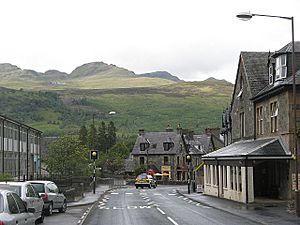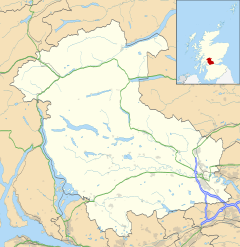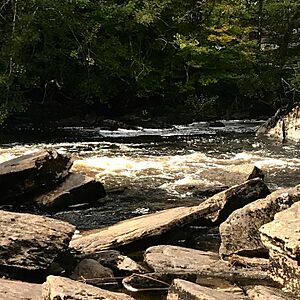Killin facts for kids
Quick facts for kids Killin
|
|
|---|---|
 Main Street, Killin, with Meall nan Tarmachan in the background to the north |
|
| Population | 740 (2020) |
| OS grid reference | NN572328 |
| Civil parish |
|
| Council area | |
| Lieutenancy area |
|
| Country | Scotland |
| Sovereign state | United Kingdom |
| Post town | Killin |
| Postcode district | FK21 |
| Dialling code | 01567 |
| Police | Central Scotland |
| Fire | Central Scotland |
| Ambulance | Scottish |
| EU Parliament | Scotland |
| UK Parliament |
|
| Scottish Parliament |
|
| Website | www.killin.info |
Killin (pronounced "Kil-IN") is a village in Perthshire, located in the central Scottish Highlands of Scotland. It sits at the western end of Loch Tay and is managed by the Stirling Council. Killin is a historic village that is part of the Loch Lomond and The Trossachs National Park. It is the main village in the old region of Breadalbane.
Killin is known for its important history, especially as a place where the Gaelic language and culture (called the Gaidhealtachd) were strong in Perthshire. It is also a popular spot for seeing wildlife and enjoying outdoor adventures.
In July 2023, a travel website called Planetware.com said Killin was one of the best places to live and visit in Scotland. This was because of its rich history, beautiful setting, and good facilities. Also, in July 2021, a company that looks at mental health named Killin the second-best holiday spot in the UK for feeling well and relaxed.
Contents
Where is Killin? Exploring its Name and Location
The western part of Killin is beautifully set around the amazing Falls of Dochart (in Scottish Gaelic, Eas Dochard). A narrow, old stone bridge with many arches crosses these falls. This bridge carries the main A827 road into Killin.
The main street then goes down towards Loch Tay. This is where two rivers meet: the Dochart (Abhainn Dochard) and the Lochay (Abhainn Lòchaidh). The A827 road lets you drive to Killin from the south and west. It takes about 90 minutes to get here from major Scottish cities like Edinburgh and Glasgow. The A827 also comes from the north and east, but this route is higher up and follows the edge of Loch Tay (Loch Tatha).
Killin is the main village in the historic area called Breadalbane. In Gaelic, Breadalbane means "the high part of Scotland." This name fits well because tall, striking mountains surround the village. These include Meall nan Tarmachan and the Ben Lawers range, which make the village look like it's in the Alps.
The name Killin (Cill Fhinn) comes from Scottish Gaelic. This shows that Gaelic was the main language here for most of history. Killin is sometimes translated as "fair or white church." But it can also mean "Finn's church or cell." This second meaning connects to an old story that Fingal, a mythical hero from the Ossian tales, is buried in the hills above the village.
A Glimpse into Killin's Past
Killin has a very old history, with lots of signs that people lived here long ago. You can find several Iron Age artificial islands, called Crannogs, along the shores of Loch Tay. A rebuilt example of a crannog can be seen at the Scottish Crannog Centre. Other signs of ancient life include a well-kept stone circle, the Kinnell Stone Circle, near the village. There are also remains of old hill forts in the area.
For a time, Killin was a battleground in the wars between the original Picts people of Highland Scotland and the Gaels who came from Ireland. This was before they all united under Kenneth MacAlpin.
The MacNab Clan used to be very powerful here and has long been connected to Killin. Their old burial ground is still on Inchbuie, an island in the River Dochart, just below the falls. You can reach it from the bridge.
Kinnell House was the home of the MacNabs. A well-preserved prehistoric stone circle called Kinnell Stone Circle is in the grounds of the house. North of the village are the ruins of Finlarig Castle. This was a strong castle belonging to the Campbells of Breadalbane, with its own chapel. The Campbells grew more powerful and eventually took Kinnell House from the MacNabs. In 1694, Sir John Campbell of Glenorchy made Killin a Burgh of barony, which gave it special rights as a town. In 1949, Kinnell House returned to the MacNab Clan Chief. But in 1978, the Chief had to sell most of the estate because of taxes.
In August 1749, after the Jacobite rising of 1745, an event known as the Killin incident of 1749 happened. Two men were caught by soldiers for wearing traditional Highland dress, which was illegal due to the Dress Act 1746. But a large crowd helped them escape.
In 1767, James Stuart, the minister of Killin, published the first New Testament in Scottish Gaelic.
By the late 1700s, Killin had a local linen industry. Farmers grew flax nearby, which was then spun into thread in small mills. Weavers then made this thread into linen cloth in their homes. Today, Killin serves the local farming community and the growing tourism industry. Besides walking on Ben Lawers National Nature Reserve, you can go fishing for trout and salmon. Many watersports are also available on Loch Tay. Many old local buildings have been kept or updated, helping the village keep its historic look.
The 19th-century Moirlanich Longhouse in nearby Glen Lochay is a rare example of a Scottish longhouse built with a special "cruck frame." It is now looked after by the National Trust for Scotland. The old Breadalbane Folklore Centre, in the Victorian mill by the falls, shows the 'healing stones' of Saint Fillan.
Tomnadashan Mine, an old copper mine above the village, is sometimes said to be where the famous Rabbit of Caerbannog from the movie Monty Python and the Holy Grail lived. Also, nearby Glen Lochay is where Richard Hannay, played by Robert Donat, goes in Alfred Hitchcock's 1935 film The 39 Steps.
Killin railway station was part of the Killin Railway. The station officially closed on November 1, 1965.
Local Stories and Traditions
Killin has many old stories and customs, mostly passed down through Gaelic oral tradition.
There are many local tales about magical creatures and strange events. These include stories of Each-uisge (Water horses) that were said to trick children into the water and drown them. Tarbh-Uisge (Water bulls) were thought to be dangerous to people and could have babies with regular cows. Sìthean (Faeries) were mischievous and risky. Ùruisg (water spirits) were troublemakers. And Ban-sìth (Banshee) screams were signs that someone was about to die. There were also many stories about people with special powers, like witches or those with An Dà Shealladh (the second sight), who could see the future. The most famous of these was Am Ban-Tighearna Labhar (The Lady of Lawers).
Local stories say that Fingal, the mythical hero from the Ossian tales, is buried in Killin. A large standing stone just above Breadalbane Park in the village center is said to be the headstone from his grave.
The area also has many local legends about healing pools and stones. The most famous are the healing stones of St Fillan. The old tradition of putting St Fillan's stones back in place on Christmas Eve is still done today as part of the local Christmas celebrations.
In Killin, it was traditional to celebrate Oidhche-Samhna (Halloween) on the old pagan date of November 11. It's not known when it changed to October 31, but it was celebrated on the old date until at least World War I. Halloween was always celebrated with teintean-aighir (bonfires) lit in Coire nam Bonnach, just above the village, where people danced and had fun. There were Gìsearan (Guisers) who would visit homes to perform poems, jokes, or songs and receive gifts of money or food. Local children often played pranks, like taking and hiding gates from people's gardens.
It was also a tradition in Killin for Hogmanay (New Year's Eve) to be a bigger celebration than Christmas. It was a special day with special drinks and foods, and visitors were welcomed into homes.
People in Killin (and West Perthshire) still feel strongly connected to their Perthshire identity. Killin, like other parts of West Perthshire, became part of Stirling Council after local government changes in 1973. Even though Perthshire is no longer a council area, it is still a registration county, and most locals still say they are from Perthshire.
Gaelic Language in Killin
Killin has been a Gaelic-speaking village for almost all of its recorded history. English has only slowly become the main language here over the last 100 years. The village has always had the highest number of Gaelic speakers in West Perthshire, even now. This makes it a very important cultural and historical place for the Gaidhealtachd (Gaelic-speaking areas) of Perthshire.
One of Killin's most important Gaelic cultural contributions was the first Gaelic translation of the New Testament. James Stuart, the Minister of Killin, finished this in 1767. Another important contribution is The Killin Collection, a group of Gaelic songs from the area collected by Charles Stewart in 1884.
Information about Gaelic in Perthshire and Stirling shows how the language has changed in Killin over more than a century:
In 1881, when Gaelic language ability was first counted in Scotland's census, Killin village had 340 Gaelic speakers (71.9%). Rural Killin had 422 speakers (80.1%). The wider Killin parish had over 1,100 Gaelic speakers, which was 78.5% of its total population. About 5% of these (56 people) spoke only Gaelic. By 1901, these numbers had dropped to 62.5% for rural Killin, 49.3% for Killin village, and 48% for the wider parish.
Like other Gaelic-speaking parts of Scotland, there has been a slow shift from Gaelic to English. Even so, it was still common to hear native Perthshire Gaelic spoken in and around Killin in the 1960s and 70s. The 1961 census counted 138 Gaelic speakers in Killin, including the last person recorded who spoke only Gaelic. In the 1971 census, there were 120 Gaelic speakers, but none spoke only Gaelic. By the 2001 census, the Killin area had only 63 Gaelic speakers (4.7% of the local population), with 39 (5.9%) in Killin village. Despite this drop, Killin still had the most Gaelic speakers in all of West Perthshire.
The Perthshire dialect of Gaelic is now almost gone, but a few older speakers have recently been found. However, because the language is not being passed down in the community, any remaining speakers in the Killin area will likely be the last generation to speak native Perthshire Gaelic.
The decline of Gaelic in the area is similar to what has happened across Scotland. This is due to several things, including the Highland clearances (Gaelic: Fuadaichean nan Gàidheal). During these clearances, many local people were forced to leave their land. The Education (Scotland) Act 1872 also made it illegal for Gaelic speakers to be taught in their language or use it in formal schools. These and other changes have led to the decline of the language across the Highlands and Islands of Scotland.
More recently, Killin has especially suffered because Stirling Council does not offer Gaelic Medium Education (GME). This is different from the nearby Perth and Kinross Council, which offers weekly Gaelic lessons at Glen Lyon primary school, close to Killin, and full GME at Breadalbane Academy in nearby Aberfeldy. The closest GME offered by Stirling Council is at Riverside Primary School in Stirling.
Despite these challenges, Gaelic survives in the area among a small number of local speakers. It also lives on in the language, history, folklore, and many place names of the area. The Killin Music Festival is a popular 3-day music festival held in the village every June, featuring Gaelic/Celtic and Folk music.
The last known native speaker of Perthshire Gaelic, Elizabeth Christina McDiarmaid, passed away in April 2024 at 92 years old in Killin. She was originally from nearby Lawyers.
Village Life and Services
Killin is a popular place for tourists and has a lively community. There are many local groups, including a drama group, a badminton club, and a youth group. The village also has many useful services for both locals and visitors.
The Killin News is a free community newspaper that comes out every two months. You can get it by subscribing or find it in local shops and businesses.
There are several hotels and traditional Inns with restaurants that serve both locals and hotel guests. The village also has several cafes, a post office, a chemist, and small shops. These include two gift shops and an outdoor center where you can rent outdoor gear. There is also a small but well-stocked Co-op food store.
A petrol station is available at Lix Toll, where the main A85 road meets the A827, which leads into Killin.
There is a well-equipped children's play park in Breadalbane Park, located in the center of the village.
Killin has a small primary school with 56 students. For high school, students travel about 21 kilometers (13 miles) south to Callander. Killin has been an important part of the Gàidhealtachd (Gaelic-speaking area) for many generations. However, the closest Gaelic medium primary schools are in Stirling, about 37 kilometers (23 miles) south, and Aberfeldy, about 23 kilometers (14 miles) to the east.
Fun Things to See and Do
Killin is a great starting point for exploring both the Scottish Highlands and central Scotland. You can easily take day trips to places like Oban and Glencoe in the Highlands. Market towns like Aberfeldy and Crieff are also close. Larger cities like Glasgow, Stirling, Perth, Dundee, and Edinburgh are all a short drive away.
Right in the Killin area, there's a lot to explore, especially if you love the outdoors.
- Killin is a common base for hillwalking because it's central and close to several Munros (mountains over 3,000 feet), including the Meall nan Tarmachan and Ben Lawers ranges.
- Ski touring is popular in the mountains here. Killin is only about a 40-minute drive to Glencoe Ski area. This area has good skiing for beginners and Scotland's longest and steepest runs.
- The Heart 200 driving route, a long road trip through Perthshire similar to the North Coast 500, goes through the village.
- Ben Lawers National Nature Reserve has internationally important examples of alpine plant life.
- The Scottish Crannog Centre museum has a rebuilt crannog on Lochtayside. This shows what life was like for ancient people in the area.
- Kinnell Stone Circle stands in the grounds of Kinnell House in Killin.
- The Falls of Dochart, beautiful rapids on the River Dochart, are the main feature of the village.
- The ancient Clan Macnab Burial ground is on Innis Buidhe, an island you can reach from the Dochart Bridge in the village center.
- The Moirlanich Longhouse Museum in Killin shows visitors what Highland life was like in the past in a preserved old house.
- Glen Lyon is just above the village in the Loch Rannoch and Glen Lyon National Scenic Area.
- Seeing wildlife is popular here. You might spot red squirrels, pine martens, otters, beavers, ospreys, and even Scottish Wildcats. Wildlife tours are offered in nearby Dull by Highland Safaris.
- The Firbush Outdoor Centre is a few miles east of Killin on the shore of Loch Tay. It's owned by Edinburgh University and offers many outdoor activities and places to stay.
- Killin Golf Club has a beautiful 9-hole course.
- The Rob Roy Way, a 127 km (79 mile) long walking path, goes through Killin.
- National Cycle Route 7 also runs through the village.
Annual Events in Killin
The village has a lively local community and hosts several events each year. These include:
| Event | Month | What Happens |
|---|---|---|
| Duck Race | April | A fun family duck race held on either the River Dochart or River Lochay. |
| Killin Music Festival | June | A popular yearly music festival. |
| Killin Highland Games | August | A traditional Highland event with competitions for music, dance, strength, and sports. |
| Killin Agricultural Show | August | A public event showing farm equipment, animals, and activities related to farming. Locals can also join a Scarecrow competition. |
| Killin 10K and 5K Races | September | Running races organized by Tay Fitness Events. |
| Swim Loch Tay | September | A swimming competition held on Loch Tay. |
| Santa Dash | December | A fun family run where all runners dress as Santa. |
| Hogmanay Fireworks Display | December | Fireworks are set off at midnight on Hogmanay (New Year's Eve) on the Dochart Bridge to welcome the new year. |
| 30/12 Concert | December | A live music event held on December 30 (usually with popular Scottish music) run by the Killin Music Festival. |
| New Year's Day Ceilidh | January | A traditional Scottish dance party held on January 1. |
Notable People from Killin
- Rev Prof Patrick Campbell MacDougall FRSE (1806-1867), a Professor of Moral Philosophy at the University of Edinburgh, was born in the manse (minister's house) in Killin.
Images for kids
See also
 In Spanish: Killin para niños
In Spanish: Killin para niños











